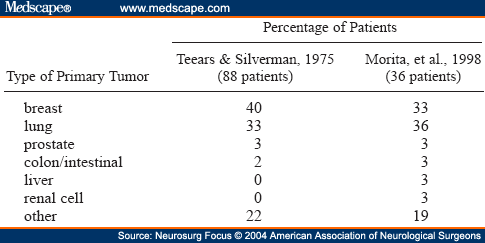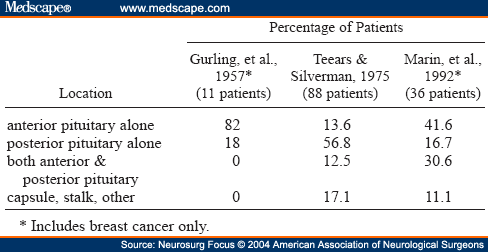Abstract and Introduction
Only 1% of all pituitary surgeries are performed to treat tumors that have metastasized to the pituitary gland; however, in certain cases of malignant neoplasms pituitary metastases do occur. Breast and lung cancers are the most common diseases that metastasize to the pituitary. Breast cancer metastasizes to the pituitary especially frequently, with reported rates ranging between 6 and 8% of cases.
Most pituitary metastases are asymptomatic, with only 7% reported to be symptomatic. Diabetes insipidus, anterior pituitary dysfunction, visual field defects, headache/pain, and ophthalmoplegia are the most commonly reported symptoms. Diabetes insipidus is especially common in this population, occurring in between 29 and 71% of patients who experience symptoms.
Differentiation of pituitary metastasis from other pituitary tumors based on neuroimaging alone can be difficult, although certain features, such as thickening of the pituitary stalk, invasion of the cavernous sinus, and sclerosis of the surrounding sella turcica, can indicate metastasis to the pituitary gland. Overall, neurohypophysial involvement seems to be most prevalent, but breast metastases appear to have an affinity for the adenohypophysis. Differentiating metastasis to the pituitary gland from bone metastasis to the skull base, which invades the sella turcica, can also be difficult. In metastasis to the pituitary gland, surrounding sclerosis in the sella turcica is usually minimal compared with metastasis to the skull base.
Treatment for these tumors is often multimodal and includes surgery, radiation therapy, and chemotherapy. Tumor invasiveness can make resection difficult. Although surgical series have not shown any significant survival benefits given by tumor resection, the patient's quality of life may be improved. Survival among these patients is poor with mean survival rates reported to range between 6 and 22 months.
Metastatic disease in the pituitary gland accounts for only 1% of all pituitary tumor resections, but appears to occur more frequently with certain types of cancer.[7,21] Because of its relative rarity, there are comparatively few reports offering discussions of diagnosis and treatment modalities. In this paper, we review the literature on pituitary metastases and summarize the prevalence of this disease. We discuss associated clinical and neuroimaging findings, evaluate recommendations for treatment, and review patient outcomes.
Neurosurg Focus. 2004;16(4) © 2004 American Association of Neurological Surgeons
Cite this: Metastases to the Pituitary Gland - Medscape - Apr 01, 2004.






Comments